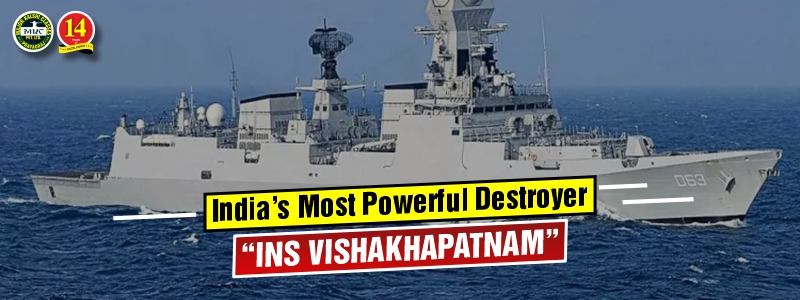India’s most powerful destroyer “INS Vishakhapatnam”
Introduction:
Table of Contents

Recently at the induction ceremony of “INS Vishakhapatnam” Defence Minister Rajnath Singh emphasized on Navy’s role and its objective of “free and open Indo – pacific region” in compliance of United Nations Convention on the Laws of Sea.
He aimed at countering China’s hostile nature in Indo – pacific and balancing with sole motive to keep safe and secure Indian Ocean.
In the event of commissioning a stealth guided missile destroyer “INS VISHAKHAPATNAM” in Mumbai, he asserted India’s importance in the region and is directly linked to world economy.
INS Vishakhapatnam:
INS Vishakhapatnam is the first of the four ‘Vishakhapatnam’ class destroyers, is a P-15B stealth guided missile destroyer. It is indigenously developed and designed by Navy’s in house organization and the Directorate of Naval design and built by Mazagaon Dock shipbuilders limited (Mumbai).
Features of INS Vishakhapatnam are:
- With the length of 163 m and displacement of over 7400 tons, which made it the largest destroyers in India.
- It is fitted with a modern surveillance radar which provides target data to the gunnery weaponry systems of the ship.
- Equipped to fight under clear, biological and chemical warfare conditions.
- Propelled by four powerful gas turbines in a combined gas configuration and capable of achieving speeds in excess of 30 Knots.
- Ship is packed with sophisticated state of the art weapons and sensors such as surface to air missile and surface to surface missile.
- It has the space to accommodate 315 personnel.
- Anti – submarine warfare capabilities are provided by indigenously developed rocket launchers and ASW helicopters.
India’s Role in Maritime Security and Indo – pacific:
China’s belligerent behaviour around both the land and sea border and its increasing military presence in the Indian ocean region can be concluded as strategy of “String of pearls”. With the modernization of China’s military base as several places in the Indian ocean region such as Djibouti, artificial island in the Maldives and the port of Gwadar in Pakistan. To counter the security challenges posed by China India’s needs a comprehensive maritime doctrine for India.
- It very important to develop blue water naval capabilities for India concerning its stakes in Indian Ocean.
- Apart from induction of indigenous naval capabilities, there is a strong need for three aircraft carrier group, one for each command and is set to operate in western, southern and eastern commands of Indian ocean.
Other Naval Developments:
INS TUSHIL:
Last month on 31 october seventh frigate of the P1135.6 class INS Tushil has been launched at the Yantar Shipyard in Russia’s Kalingrad adding a significant capability to the navy for projecting power in the Indian ocean region.
buy trazodone online rxbuywithoutprescriptiononline.net/trazodone.html no prescription
Tushil is part of 2.5 billion US dollar deal and supplied by India’s top arms destination Russia.

Poseidon Eight India (P8I):
- The long-range maritime patrol and anti-submarine warfare capable aircraft induction has provided an edge in defending and attack capability of the Indian Navy.
- It has high speed and endurance which can provide thrust to India’s immediate and extended areas of interest
- The P-8I aircraft is a variant of the P-8A Poseidon aircraft that is developed as a replacement by Boeing for the US Navy’s old P-3 fleet.
- Indian Navy has become the first international buyer for the P-8 aircraft with the final contract deal of 2.1 billion US dollars.
- It is equipped with long range anti-submarine warfare, anti-surface warfare, intelligence gathering, surveillance in support of broad area and maritime operations.
- Defence PSU’s and private manufacturers has developed its communication and sensors which include indigenous equipment.
Conclusion:
The simultaneous rise of India and China is an important paradigm shift in the international system. This new paradigm shift will require India to focus on not only land boundaries but also maritime security.
Way forward:
Establishing Sagar Panchayat –
India should collaborate with its partner countries in the Indian Ocean region who are also the part of Indian ocean rim association to establish the common good order at sea.
India’s Geo-strategic location could serve as a platform for the Indo- pacific nations into a “sagar panchayat” and to uphold the rules and laws of the sea.

Collaboration in multidimensional areas-
- India should collaborate with the like-minded countries with the purpose of the security of the sea lanes of communication, enhancing the interoperability at sea, intelligence and data sharing, maintaining the freedom of navigation.
- In this context the QUAD which is a group of four countries such as India, Australia, Japan and the United States of America is working in the direction to keep safe, secure and barrier free Indo- pacific.
- Indian can also expand the potential of the group by including ASEAN countries in it as China regularly shows its aggressive nature in the south China sea and as well as Indian Ocean.
Sea – denial capability:
In order to counter China’s increasing influence in Indian ocean. India should develop sea – denial capability mainly at choke points in Indian ocean such as Strait of Hormuz, Bab-el-Mandeb, Strait of Malacca.
For more blogs and notification subscribe to blog.majorkalshiclasses.com








